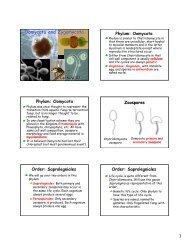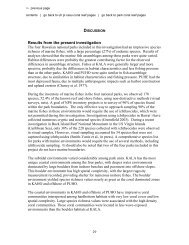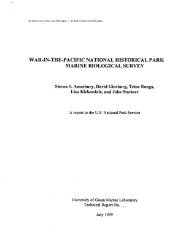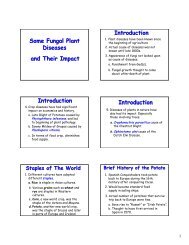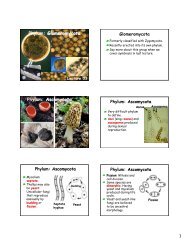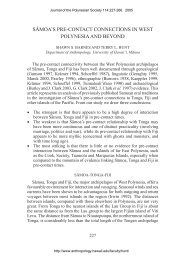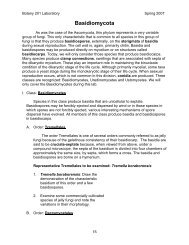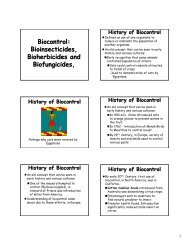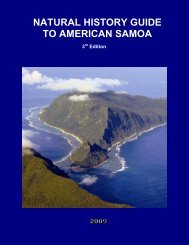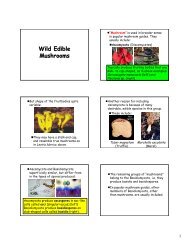american samoa - University of Hawaii at Manoa Botany Department
american samoa - University of Hawaii at Manoa Botany Department
american samoa - University of Hawaii at Manoa Botany Department
- No tags were found...
Create successful ePaper yourself
Turn your PDF publications into a flip-book with our unique Google optimized e-Paper software.
RIPARIAN RESTORATION AND ENHANCEMENT OPPORTUNITIESGeneralTwo opportunities were identified for the restor<strong>at</strong>ion and enhancement <strong>of</strong> lower Asili Stream.The scope <strong>of</strong> these restor<strong>at</strong>ion and enhancement opportunities, and rel<strong>at</strong>ed implement<strong>at</strong>ionstr<strong>at</strong>egies, are presented in the following paragraphs. The potential benefits and impactsderived from the implement<strong>at</strong>ion <strong>of</strong> the recommended str<strong>at</strong>egies are subsequently evalu<strong>at</strong>edand compared in the following paragraphs.Preliminary cost estim<strong>at</strong>es are presented for the implement<strong>at</strong>ion <strong>of</strong> the recommended str<strong>at</strong>egy.Long-term monitoring and site maintenance requirements associ<strong>at</strong>ed with the recommendedstr<strong>at</strong>egy are also identified.Opportunities and Str<strong>at</strong>egiesOption 1: Clean Asili Stream and Enhance Riparian Veget<strong>at</strong>ionThe initial phase <strong>of</strong> Option 1 would represent the clean up <strong>of</strong> solid waste m<strong>at</strong>erial within thebanks <strong>of</strong> Asili Stream. More specifically, the cleanup would occur between the stream mouthand st<strong>at</strong>ion 10+00, the first 1,000 feet upstream <strong>of</strong> the stream mouth (Figure 10-3). This effortwill require the collection and disposal <strong>of</strong> a wide variety <strong>of</strong> solid waste m<strong>at</strong>erials. Manualcollection will be sufficient to collect <strong>of</strong> this m<strong>at</strong>erial. A larger dump truck may be required tohaul larger m<strong>at</strong>erials to the Futiga landfill.Subsequently, The American Samoa Community College, Land Grant Program would initi<strong>at</strong>ethe planting <strong>of</strong> 25 ifi (Tahitian chestnut) and 25 falaga trees along the banks <strong>of</strong> Asili Stream.Such plantings would be most beneficial along the margins <strong>of</strong> subsistence plant<strong>at</strong>ions th<strong>at</strong> areadjacent to Asili Stream. Both ifi and falaga trees will help stabilize stream banks and helpdecrease potential downstream sediment<strong>at</strong>ion. It is recommended th<strong>at</strong> tree plantings are madewithin 25 feet <strong>of</strong> the east and west stream banks except where plantings interfere with adjoiningresidential land uses, or are not authorized by residents living adjacent to Asili Stream.Option 2: Restore Stream Flow P<strong>at</strong>h Upstream <strong>of</strong> Inhabited Village AreaA change in the p<strong>at</strong>h <strong>of</strong> stream flow immedi<strong>at</strong>ely upstream <strong>of</strong> the inhabited village area maygener<strong>at</strong>e future flood damages to, <strong>at</strong> least, one residence along the west bank <strong>of</strong> Asili Stream.Some corrective action will likely be required upstream <strong>of</strong> st<strong>at</strong>ion 10+00 to restore the priorp<strong>at</strong>h <strong>of</strong> stream flow.The construction <strong>of</strong> riprap upstream <strong>of</strong> the last residence in the village is recommended to helprestore the former p<strong>at</strong>h <strong>of</strong> stream flow along the west bank <strong>of</strong> the stream, as well as reducesediment<strong>at</strong>ion th<strong>at</strong> is being gener<strong>at</strong>ed from the continuing erosion <strong>of</strong> the west stream bank.Larger basaltic boulders and smaller rock are readily available within the existing stream bed.Consequently, any construction effort would require a modest expense for the m<strong>at</strong>erial neededto build the riprap. Labor and heavy equipment from the ASG <strong>Department</strong> <strong>of</strong> Public Workswould be required to haul selected rock m<strong>at</strong>erial, from the stream bed to the west bank, andconstruct the riprap structure.Figure 10-3Option 1: Clean Asili Stream and Enhance Riparian Veget<strong>at</strong>ionAmerican Samoa Wetlands/Streams Restor<strong>at</strong>ion and Enhancement PlanFebruary 2001, Asili Stream, Page 10-10



